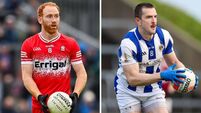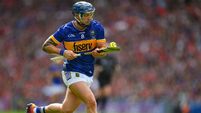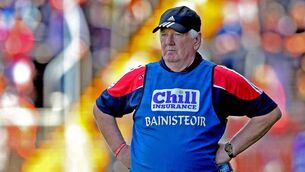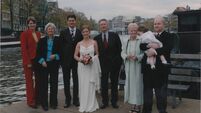Passionate Coughlan bringing science into the GAA

That led him to focus academically on skills coaching — learning why one team can execute their skills better than another, even when they’re both tired, or why one kicker can maintain calm or control at the sharp end of a game.
In another sense, though, he was following through on a conversation he had as a kid.
“In the heat of a game, you’ll often hear a commentator say about a player he always seems to have time on his hands — that was an early memory for me watching sport, and I remember asking my dad about it.
“He said, ‘that’s nonsense, we all have the same amount of time, that player just uses it better’. That always stuck with me. In all my research, elite players use their time better, down to the 168 hours we have in a week: the good guys can compartmentalise it down to incorporate social time, family time, girlfriend or boyfriend time, recovery time, training time.
“It goes all the way down to a game — they’re in possession, quick look up, move on to something else.
“Two teams that stick out like that for me in world sport are the All Blacks, who have just insane control of their time. They might be a score down and need a converted try, two minutes on the clock, but their outlook is, ‘we have a full two minutes to do it’.
“The other team is the San Antonio Spurs in the NBA, who have a clear understanding of how their game works in clutch situations because they have an understanding of time. From years ago talking to my dad to analysis nowadays, there’s a common thread.”
That “analysis nowadays” is worth examining. Coughlan offers a slight caveat to the newish lust for data and stats in sport.
“We met the lads from Avenir Sports recently, great guys, and we were going through what’s out there for different teams and so on.
“The lads were telling us how much objective data that you can get, and what I was thinking was, ‘that’s interesting but what you need with all that data is some subjectivity — a player may have run 15k in the game, but he did so without touching the ball’.
“I was involved in a game and we had six of our guys on GPS, so did the opposition. The guy doing the GPS asked if we’d mind sharing data, and I knew the opposing coach, so I said ‘go for it’.
“Afterwards we got the data, and the GPS guy said, ‘look, the opposition ran further than your guys, faster, more agility runs, and so on’. They beat us on seven markers.
“‘What are you going to tell the other guy?’ I asked. ‘They never scored in the second half and we beat them off the park.’
“Now he’s a good guy, he was saying ‘the data doesn’t lie’ and I was saying, ‘I know it doesn’t, but they never scored in the second half — what am I going to tell my lads, they’ll have to run further even though they won the game?’”
Isn’t that a valid undercurrent to the slight distrust of stats — that there’s a sense of chaff and wheat to the harvest?
“No doubt. In any set-up where I’ve used GPS, the GPS works when the guys running it use key markers. Remember, the GPS unit will give you 87 different pieces of data, but what can you do with that? The good guys know how to use the tool, and what parts to use, and if you have that expertise, it’s a phenomenally helpful tool.
“Where it’s used a lot — and is helpful — is in return to play from injury. A guy coming back from injury, you can measure what percentage of his max speed he can do, what he’s able for in a training session as he comes back — say 3k in running.
“With the laptop measuring that at the side of the pitch during a session, you can tell him, ‘you’re done’ when he reaches that marker, and you’re protecting him.
“Player welfare is much better, and the guesswork from years ago — ‘ah he’ll be able for it’ — is gone.
“The player will always want to do more, of course, but now that can be measured objectively.”
Coughlan spent four years as a strength and conditioning coach with the Mayo footballers, but his new posting is as skills coach with the Dublin senior hurlers.
Which prompts the question...
“What a skills coach does? The idea is that he works closely with the field coach, who deals with tactical stuff and so on.
“The skills coach works on things which are difficult to cover in large groups. Say one player’s decision-making needs to improve. It’s difficult to work on that specifically if there are 15 guys standing around in the group.
“Spatial awareness — finding space, using space — is something else you can work on, as is vision training, like non-dominant eye training.”
What’s that?
“I’m left-eye dominant,” says Coughlan.
“My left eye is actually weaker, vision-wise, than my right, but my field of vision is better from my left, particularly my peripheral vision.
“If something happens on the edge of my right eye’s vision, then I’ll turn my head to pick it up with my dominant left eye before my right eye picks it up.
“That’s a trainable skill. In Gaelic football, hurling, fast sports, you’re looking for those little advantages, and it would obviously be a help if a guy doesn’t have to turn his head to pick stuff up.
“Visual acuity is another area — helping a guy to focus better, to concentrate — and skill execution is what tops it off, making sure players have skills that are robust when you most need them to be.”
They need those skills to hold up at the elite level in part because of the level of analysis: “If a coach says to me, ‘we’re pretty sure this guy has been analysed by the opposition, they know he only has a left side, that he’ll never turn on to his right’, then he coach will ask me to make him turn naturally to his right as well, to start adding that to his game maybe early in the season, to work on it for a while, so that when it comes to the day of days, he’ll turn to his right. Then his marker — who’s been told by the opposition analyst that his man will turn to his left — is flummoxed, hopefully.”
That’s fine if you’re coaching elite players, though. What about the man or woman trying to coax an extra per cent or two from a junior team?
“Well, how people learn is very interesting. If we feel a player has a block against learning something — if management ask themselves, ‘why doesn’t this guy learn, he’s always switching off?’ — then you can use a simple online questionnaire, the VARK questionnaire.
“The V is for visual, A for aural, R for read and write, and K for kinesthetic — the four ways people learn.
“It’s not as if people only learn one way, but they can be heavily dependent on one method. If you have a situation — and I’ve seen it many times — where you set up a drill and one player is the last guy to get a drill, then it may be that while you set up the drill, talking to the players, he could be a visual guy who might like to see it being done first, or a picture of it. Or maybe he wants to have it explained in four or five lines of text.
“That might seem high end, but if you can identify how people learn, then you’re tapping into something significant. You can’t say ‘they’re all different’ and then treat them all in the same way.
“In my time in Mayo one of the joys was 30-odd players and 30-odd programmes. and they’d look at each others’ programmes and say, ‘you have me doing this twice but he’s doing it 10 times’ or whatever.
“And you’d say, ‘well, you’re both midfielders, but you’re six four and 95kg and he’s six five and 89kg: you’re completely different.’ And people react and adapt differently to stimuli — we see that in studies of twins. Take a kicker. I have a multitude of different ways to work with a kicker, depending on how he works, not my way and fitting him into that — that approach isn’t skills coaching.”
The Mayo years mean he’s looking forward to 2015: “You see Tommy Walsh coming back from Australia now to Kerry, and what you try to do is identify what he’s used to, where are they going to slot him in comfortably?

“Do you put him in that environment quickly, and get them comfortable first, and then see how we can — gently — meld them into a less comfortable environment as well?”
Coughlan has first-hand experience of that melding process: “Watching Gavin Duffy come in from Connacht Rugby last year with Mayo was phenomenal.
“Without doubt he made exponential gains every session and you can’t make those gains unless you’re bringing an awful lot to the table yourself — whether that’s his own skill set, playing (rugby) full-back, where the game is in front of him, and transferring that to half-back or midfield in GAA, where a lot of the game is still in front of you.
“Then there’s the physicality, which he added to it from his pro background, as well as speed, both of which he had from rugby.
“Add in his ability to apply himself, which experts have — to look at what they need to work at. That’s the only way to make those gains, not to mind the urgency with which he approached everything with Mayo. That was incredible. Genuinely so.
“What was also interesting with Gavin was how he slotted in. He wasn’t different. It was a mark of the lads who were there, and are there, there was no difference. Gavin didn’t come in and we didn’t up our standards, because there was nothing for him to come in and ‘up’, as it were. I’d be confident he’d have the same view of that.”
Before we leave Duffy, Coughlan isolates that frustration tolerance as a marker of high achievers: “They have this capacity to put up with working on something that’ll frustrate them for a while — they have that long-term vision, that what they’re doing isn’t going to be inherently enjoyable or immediately rewarding for a while.
“It’ll be effortful, cognitively, to acquire it, but they have that capacity to deal with it, which is built up over years.
“And good coaching helps with that, creating environments which are correct for the players involved, particularly if they’re small kids learning a game — to give them credit for what they’re able for and to be clever in setting the tasks, that those are at or just above the level needed for a game situation.
“If you do that then those kids will leapfrog kids in a strictly controlled drill-based environment. There was a great report done in Australia years ago with kids coming in over a few weeks for two different training sessions, one structured, organised, and drill-based, the other more chaotic and game-based.
“Their parents were asked to evaluate the sessions, and they said the drill-based session was very organised while the other was chaotic.
“The kids preferred the noisy, chaotic environment, but that was also the environment which produced the kids with better skills.”
The Corkman sees Australia and New Zealand as topping the league in terms of coaching skills, particularly in terms of developing game sense.
“That always reminds me of Mickey Whelan in Dublin — he was years ahead of his time and we’re now trying to catch up with him.
“For me basketball is the ultimate sport in terms of coaching. It’s so fast, there are so many changes — I worked with the (UL) Huskies for a couple of years and it was a joy to be that close to a team at that level.
“Basketball is all about simulation, scenarios, ‘we’ll do what the opposition do and counter that in training’ — that’s not done nearly enough in Gaelic games and soccer, but it’s a given in basketball.
“They’ll model it out, they have their plays — the coaching culture in basketball is a study in itself.
“You’re running plays but you’re not running drills over and over — Ray Allen, one of the greatest three point shooters of all time, doesn’t stand on the three-point line and shoot, he’s moving, shooting, moving, shooting.”
Those principles apply in other sports.
“I’m often asked to do time and motion analysis of coaching sessions.
“You sit down with the coach beforehand and ask what the plan is for the next session. The coach will say, ‘this is the plan, such and such for 10 minutes, such and such for 10 minutes’ and so on.
“What are the priorities? ‘Oh, breaking ball is a big issue for us or tackling,’ or whatever. “For the session I’ll sit and watch, put a clock on when the first person hits the field.
“I go off afterwards and do a report, and often it’s a case of saying, ‘before the session ye said a priority was breaking ball, and yet in 80 minutes training ye spent six minutes on breaking ball. Ye spent 10 minutes on skill X, though that was never mentioned as a priority; the game ye finished the session with, there was nothing set up to produce breaking ball scenarios to improve the players.’
“Coaches know the game, but the fear is always that they end up coaching the way they were coached, and their coach went back to how he was coached, and that means you can have a coaching style that goes back 100 years.
“That’s fine if you’re going back to a Mickey Whelan as the original coach, but there aren’t too many of those around.”
No. But with the likes of Ed Coughlan that picture could brighten considerably.












